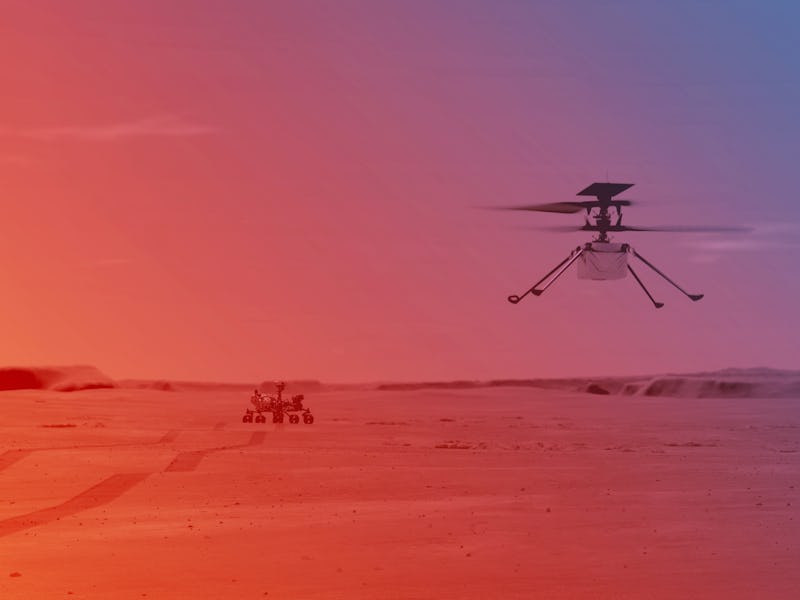Inverse Daily: It’s Mars helicopter week 🚁
Plus: The evolutionary reason all your friends made babies during the pandemic.

And we’re back. After taking Friday off, Inverse Daily returns to your inbox with stories about the future of electric cars, the reasons your friends made those dramatic life decisions during lockdown, an urgent study on psychotic mice, and a slightly terrifying story about man’s best friend.
Plus: I’m declaring it Ingenuity Week in honor of NASA’s attempt on Thursday to conduct a controlled flight of a helicopter on Mars. Keep opening Inverse Daily for trivia, guides, and a few surprises about this little piece of history-in-the-making. And read more about it at the bottom of this daily dispatch.
I’m Nick Lucchesi, editor-in-chief at Inverse. Let’s dive in.
This is an adapted version of the Inverse Daily newsletter for April 5, 2021. Subscribe for free and earn rewards for reading every day in your inbox.
Lexus LF-Z 2021 might be the future of electric cars — “Just build this, Lexus. Sell it. Now. Please. We're begging you.” That’s the plea from auto writer Jordan Golson:
Lexus says the LF-Z “incorporates driving performance, styling, and technologies envisioned” for the near future. Lexus says it aims to offer electric variants — hybrids, plug-in hybrids, or fully electric — of all its models by 2025.
More like this:
- GMC Hummer EV: Price, release date, “WTF mode” for the colossal new electric SUV
- Behold! The Huracán EVO is the first car that can be fully controlled with Alexa
- BMW’s new electric cars are ready to compete with Tesla
The reason your friends made babies during the pandemic — In the face of the Covid-19 pandemic, people were plunged into psychological limbo. Some responded by making major life decisions and starting their life fresh, writes Elizabeth Svoboda.
Eileen Cotter Wright and her husband went back and forth about whether to have a child for years.
A prolific travel blogger who visited at least a dozen countries a year, Wright felt most in her element exploring new places. Swapping it all for parenthood seemed like climbing El Capitan without a harness.
Everything changed last February. As the trickle of reports about Covid-19 became a deluge, Wright and her husband sat down to talk about what was happening.
“We had a really distinct conversation,” she says. “Like, ‘Is this gonna be a thing for a while?’”
More like this:
- One life hack that's key to coping with lockdown
- 9 gaming figures reveal how their habits changed during lockdown
- The deadly link between pandemics, forests, and peanut butter
Psychotic mice reveal what happens to the brain during a hallucination — A new study in mice offers scientists a clear picture of the biology driving hallucinations in humans and points to new treatments, reports Katie MacBride.
It’s estimated that 20 million people in the world have schizophrenia, and about 75 percent of people with the condition experience auditory hallucinations. But what happens in the brain during a hallucination has proven difficult to tease out. Thanks to a new study in mice, scientists are starting to get a clear picture of the biology behind this strange phenomenon.
More like this:
- Why A.I. knows who you find attractive better than you do
- Psychedelics may be able to treat these 11 mental health conditions
- Brain scans solve an enduring mystery about our love of music
Study finds these 3 dog breeds are most at risk for cancer — New research identifies blood cancer risks in three dog breeds, suggesting the results could also be used for cancer studies in humans, reports Tara Yarlagadda.
Dogs are called man’s best friend for a good reason, sticking with us through thick and thin over thousands of years.
But according to new research, they might not just be valuable companions; they could also potentially save our lives from dangerous diseases.
More like this:
- 10,000-year-old dog bone changes what we know about the first Americans
- Are dogs self-aware? A new study reveals what canines think
- The truth about what your dog's bark really means
Ingenuity, the Mars helicopter sent to the Red Planet by NASA, will attempt to fly for the first time on Thursday.
One more thing... it’s Ingenuity Week. NASA’s Perseverance rover landed on Mars on February 18 with the mission to search for evidence of ancient microbial life that may have once lived on the Red Planet. However, the rover didn’t venture out to Mars on its own. It had a lil’ chopper in tow.
Ingenuity is the first attempt to conduct a controlled flight on another world. (Two balloons were released on Venus in the 1980s by the Soviet Union.) The helicopter is only 19 inches tall, with two four-foot-long carbon fiber rotors spinning in opposite directions.
On Thursday (April 8), it will attempt to fly for the first time. NASA is not shying away from big comparisons, going as far as sitting this week’s event alongside the Wright Brothers’ flight at Kitty Hawk in North Carolina in 1903.
That wraps up this edition of Inverse Daily. I would like to thank you for reading so loyally! You can follow me on Twitter at @nicklucchesi, where I share some of my favorite stories from Inverse, Input, and Mic every day.